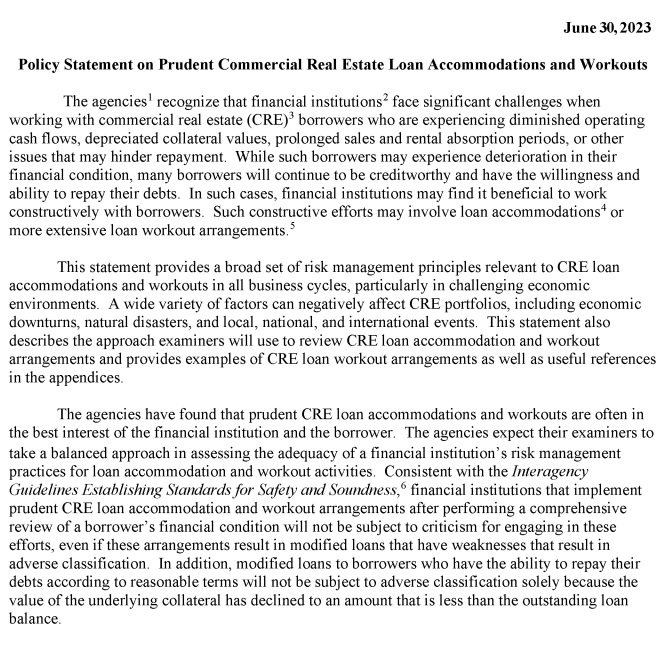About six weeks ago, the federal banking authorities (Feds) issued a new Policy Statement, a revamp and expansion of the 2008 "extend and hold" or "pretend and extend" policy that emerged from the 2008 Bank Liquidity Crisis.
Like 2008, the Feds recognize four huge factors:
- A real estate financing crisis is beginning, and will significantly worsen in 2024 and 2025 when $4-5 Trillion in office loans will mature and need to be refinanced. This is due to Post Pandemic economic conditions in the real estate industry, especially office properties, where the national average vacancy rate is 18.2% and fair market values nationwide are down approximately 30%.
- The above crisis in the office market will affect other real estate sectors, such as retail, hotels, multi-family properties, etc., as the effects of an office market collapse and a banking collapse will spread throughout the real estate and banking industries.
- This problem is NOT the fault of over-development by property owners or lax lending oversight (like the 1980s S&L Crisis); instead, good, hard-working middle American and foreign companies were and are still caught in the effects of an unexpected, once in a century, pandemic. Literal enforcement of banking regulations would wipe out an incalculable number of large, middle, and small American and foreign companies, resulting in an industry collapse.
- Even if the Feds were to disregard innocent property owners, they do not want to crash the banks, as happened in the 1980s S&L Crisis, when banks and savings and loans foreclosed on and ate the losses of the entire property market collapse. Therefore, if nothing else, to save the banks, the Feds have to relax literal compliance with current banking regulations.
The Policy Statement discusses how the Feds will view upcoming workouts and restructurings used to avert the aforementioned crises, including, various elements of a lender's review and analysis such as the future likelihood of debt service payments, the ability of guarantors and sponsors to assist in supporting repayment of the debt, assessment of collateral values, how certain workout arrangements would be classified by the bank's auditors, and whether such arrangements would be classified by the auditors as accrual or non-accrual. The Policy Statement also provides specific examples of different loan extension scenarios for office, retail, hotel, residential, construction of single family residences and commercial properties, owner occupied properties, land loans and multi-family, and how each scenario would be classified for loan grading and accrual or non-accrual purposes.
In the Policy Statement, the Feds explain that, even in cases where the fair market value of a property has actually fallen below the outstanding principal balance of the loan, i.e., the property is worth less than the debt, banks can still extend the term of the loan if the extension is made in circumstances where the borrower can show it can continue to pay debt service (preferably at current market interest rates) and prospects for repayment of the loan, "on reasonable terms," can be seen due to positive actions by the borrower, guarantor and/or sponsor to support the property.
The Policy Statement's overall first page introductory explanation is set forth below:

Examples of CRE Loan OFFICE Workout Arrangements
In addition to laying out the rationale and methodologies that banks and examiners should follow, the Policy Statement also provides examples of extended office property loans and how banks and examiners should classify each type of scenario. These examples are helpful when examining the pros and cons of your property and evaluating and planning your options and approach when you meet with your lender.
For examples of loan extension scenarios for multiple types of different properties, click here to read examples in their entirety with footnotes. As this piece focuses on Office properties, below are scenario examples provided in the Policy Statement covering Office properties.
Income Producing Property – Office Building
Base Case
A lender originated a $15 million loan for the purchase of an office building with monthly payments based on an amortization of 20 years and a balloon payment of $13.6 million at the end of year five. At origination, the loan had a 75 percent loan-to-value (LTV) based on an appraisal reflecting a $20 million market value on an "as stabilized" basis, a debt service coverage (DSC) ratio of 1.30x, and a market interest rate. The lender expected to renew the loan when the balloon payment became due at the end of year five. Due to technological advancements and a workplace culture change since the inception of the loan, many businesses switched to hybrid work-fromhome arrangements to reduce longer-term costs and improve employee retention. As a result, the property's cash flow declined as the borrower has had to grant rental concessions to either retain its existing tenants or attract new tenants, since the demand for office space has decreased.
Scenario 1:
At maturity, the lender renewed the $13.6 million loan for one year at a market interest rate that provides for the incremental risk and payments based on amortizing the principal over the remaining 15 years. The borrower had not been delinquent on prior payments and has sufficient cash flow to service the loan at the market interest rate terms with a DSC ratio of 1.12x, based on updated financial information. A review of the leases reflects that most tenants are stable occupants, with longterm leases and sufficient cash flow to pay their rent. The major tenants have not adopted hybrid work-from-home arrangements for their employees given the nature of the businesses. A recent appraisal reported an "as stabilized" market value of $13.3 million for the property for an LTV of 102 percent. This reflects current market conditions and the resulting decline in cash flow.
Classification:
The lender internally graded the loan pass and is monitoring the credit. The Page 16 of 39 examiner agreed, because the borrower has the ability to continue making loan payments based on reasonable terms, despite a decline in cash flow and in the market value of the collateral. Nonaccrual Treatment: The lender maintained the loan in accrual status. The borrower has demonstrated the ability to make the regularly scheduled payments and, even with the decline in the borrower's creditworthiness, cash flow appears sufficient to make these payments, and full repayment of principal and interest is expected. The examiner concurred with the lender's accrual treatment.
Nonaccrual Treatment:
The lender maintained the loan in accrual status. The borrower has demonstrated the ability to make the regularly scheduled payments and, even with the decline in the borrower's creditworthiness, cash flow appears sufficient to make these payments, and full repayment of principal and interest is expected. The examiner concurred with the lender's accrual treatment.
Scenario 2:
At maturity, the lender renewed the $13.6 million loan at a market interest rate that provides for the incremental risk and payments based on amortizing the principal over the remaining 15 years. The borrower had not been delinquent on prior payments. Current projections indicate the DSC ratio will not drop below 1.12x based on leases in place and letters of intent for vacant space. However, some leases are coming up for renewal, and additional rental concessions may be necessary to either retain those existing tenants or attract new tenants. The lender estimates the property's current "as stabilized" market value is $14.5 million, which results in a 94 percent LTV, but a current valuation has not been ordered. In addition, the lender has not asked the borrower or guarantors to provide current financial statements to assess their ability to support any cash flow shortfall.
Classification:
The lender internally graded the loan pass and is monitoring the credit. The examiner disagreed with the internal grade and listed the credit as special mention. While the borrower has the ability to continue to make payments based on leases currently in place and letters of intent for vacant space, there has been a declining trend in the property's revenue stream, and there is most likely a reduced collateral margin. In addition, there is potential for further deterioration in the cash flow as more leases will expire in the upcoming months, while absorption for office space in this market has slowed. Lastly, the examiner noted that the lender failed to request current financial information and to obtain an updated collateral valuation, representing administrative weaknesses.
Nonaccrual Treatment:
The lender maintained the loan in accrual status. The borrower has demonstrated the ability to make regularly scheduled payments and, even with the decline in the borrower's creditworthiness, cash flow is sufficient at this time to make payments, and full repayment of principal and interest is expected. The examiner concurred with the lender's accrual treatment.
Scenario 3:
At maturity, the lender restructured the $13.6 million loan on a 12-month interest-only basis at a below market interest rate. The borrower has been sporadically delinquent on prior principal and interest payments. The borrower projects a DSC ratio of 1.10x based on the restructured interest-only terms. A review of the rent roll, which was available to the lender at the time of the restructuring, reflects the majority of tenants have short-term leases, with three leases expected to expire within the next three months. According to the lender, leasing has not improved since the restructuring as market conditions remain soft. Further, the borrower does not have an update as to whether the three expiring leases will renew at maturity; two of the tenants have moved to hybrid work-from-home arrangements. A recent appraisal provided a $14.5 million "as stabilized" market value for the property, resulting in a 94 percent LTV.
Classification:
The lender internally graded the loan pass and is monitoring the credit. The examiner disagreed with the internal grade and classified the loan substandard due to the borrower's limited ability to service a below market interest rate loan on an interest-only basis, sporadic delinquencies, and an increase in the LTV based on an updated appraisal. In addition, there is lease rollover risk because three of the leases are expiring soon, which could further limit cash flow.
Nonaccrual Treatment:
The lender maintained the loan in accrual status due to the positive cash flow and collateral margin. The examiner did not concur with this treatment as the loan was not restructured with reasonable repayment terms, and the borrower has not demonstrated the ability to amortize the loan and has limited ability to service a below market interest rate on an interest-only basis. After a discussion with the examiner on regulatory reporting requirements, the lender placed the loan on nonaccrual.
While the Policy Statement does not govern CMBS loans, there is no doubt that CMBS has to consider the same issues and look at the same extension concepts. In facing the same market circumstances (and maybe even worse as CMBS loans often only use "bad-boy non-recourse guaranties instead of full repayment guaranties), CMBS should hopefully conclude that it will be best for its certificate holders not to crash the market with underwater foreclosed properties thereby killing the value of their certificates. Additionally, the above Fed standards should be used as arguments for borrowers when negotiating with CMBS as to what is reasonable in today's market.
The content of this article is intended to provide a general guide to the subject matter. Specialist advice should be sought about your specific circumstances.


